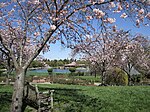Rancho Arroyo de Las Nueces y Bolbones
1834 establishments in Alta CaliforniaCalifornia ranchosDiablo RangeRanchos of Contra Costa County, CaliforniaWalnut Creek, California

Rancho Arroyo de Las Nueces y Bolbones (also called "San Miguel") was a 17,782-acre (71.96 km2) Mexican land grant in present-day Contra Costa County, California given in 1834 by Governor José Figueroa to Juana Sanchez de Pacheco.The grant was named after the principal waterway, Arroyo de las Nueces (Walnut Creek), and for the local group of indigenous Americans (known as Bolbones in Spanish, also known as Volvon). The grant was on the western slope of Mount Diablo and includes the area of the present-day city of Walnut Creek. Approximately a quarter of the original rancho has been protected since the early 20th century within the boundaries of Mt. Diablo State Park.
Excerpt from the Wikipedia article Rancho Arroyo de Las Nueces y Bolbones (License: CC BY-SA 3.0, Authors, Images).Rancho Arroyo de Las Nueces y Bolbones
Casa Bueno Court,
Geographical coordinates (GPS) Address Nearby Places Show on map
Geographical coordinates (GPS)
| Latitude | Longitude |
|---|---|
| N 37.92 ° | E -122.02 ° |
Address
Casa Bueno Court 2501
94598
California, United States
Open on Google Maps





